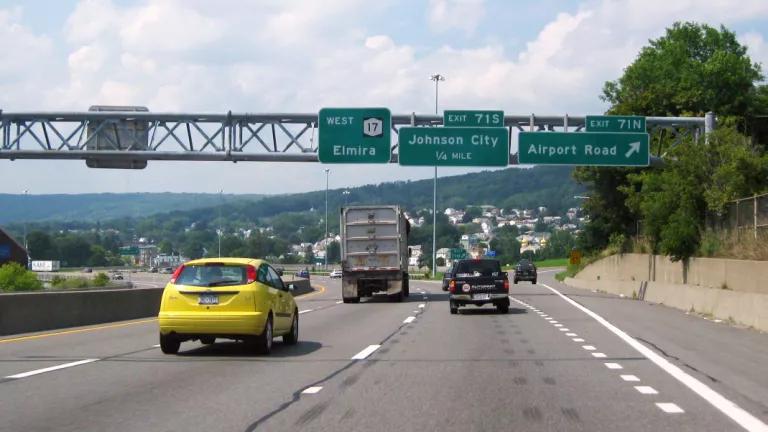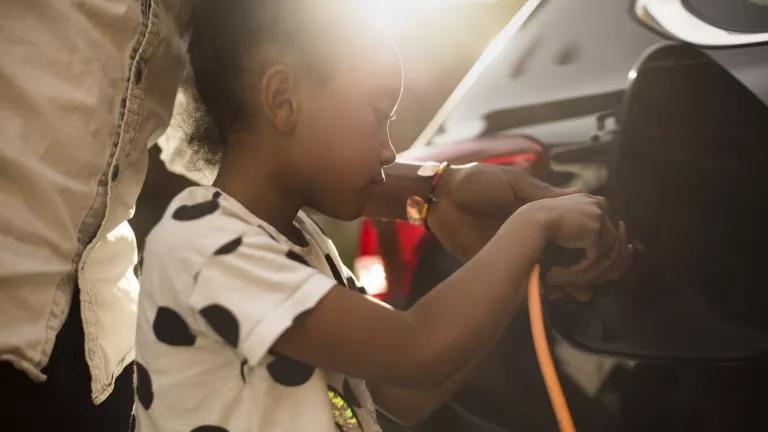Proposed Highway Expansion Will Undercut New York Landmark Climate Law
A state proposal to spend $1 billion to expand a 47-mile stretch of Route 17 in Orange and Sullivan Counties runs counter to the Climate Leadership and Community Protection Act.

Doug Kerr via Flickr, CC BY-SA 4.0
The authors thank Sierra Townsend, a law student at New York University School of Law, for her assistance with research for this blog.
New York recently released its official implementation plan for the state’s landmark 2019 climate law—the Climate Leadership and Community Protection Act—and set forth a road map to meet its central mandate to slash climate emissions by 85 percent by 2050.
Meeting this critical climate objective, however, runs directly counter to a recent Hochul administration plan to spend $1 billion on a proposal to expand a 47-mile stretch of Route 17 in Orange and Sullivan Counties.

A map of the proposed 47-Mile NYS Route 17 expansion
NYS DOT, 2021 Route 17 Planning and Environmental Linkages Study (PEL)
This plan calls for adding a third lane in both directions along Route 17 that would create more than 90 miles of new highway lanes in this Lower Hudson–Catskill region. According to preliminary estimates based on a highway calculator developed by NRDC, RMI, and Smart Growth America, adding these lanes will result in hundreds of millions of new vehicle miles traveled per year along the Route 17 corridor, with a total increase of as much as two million tons of greenhouse gas pollution through 2050.
These increases are especially troubling given that New York’s transportation sector is one of the state’s largest sources of greenhouse gas emissions—as much as 36 percent of statewide emissions—and this sector has increased 25 percent since 1990.
According to New York State’s own calculations, emissions would need to be slashed 86 percent of 2016 levels by 2050, and 31 percent of 2016 levels by 2030, to meet the state’s transportation targets under the 2019 climate law.
The reason expanding Route 17 will boost climate emissions is due to so-called induced demand. Repeated studies across the country have shown that while adding additional lanes might reduce traffic congestion in the short term, it very often increases traffic problems over the longer term as more and more people use that highway at peak times, and often to travel further. So, in the end, the highway has the same level of congestion as before, sometimes resulting in much higher traffic delays.
This is not all.
In the long run, the additional highway capacity will induce further sprawling land use development that will require more car trips. And in the case of Route 17, this will also include slicing through the Bashakill Wildlife Management Area, the Shawangunk Mountains, the Neversink River basin, and other significant natural areas along the corridor.
Incredibly, state transportation officials seem to suggest that expanding Route 17 would somehow reduce greenhouse gas emissions. This conclusion is likely due to using outdated models that do not account for induced travel from the proposed expansion.
Expanding Route 17 is not only at odds with the state’s climate law but would be inconsistent with other state laws and federal transportation requirements. Indeed, since the Route 17 expansion would rely on federal monies and approvals, the proposed project would also run afoul of several national, climate-related transportation policies. For example, new federal policy under the recently passed Bipartisan Infrastructure Law (Infrastructure Investment and Jobs Act) dictates that recipients of federal highway funds prioritize projects that reduce greenhouse gas emissions and strengthen climate resilience. This means that, in most cases, federal funds should be used to repair, improve, and maintain existing highways rather than expand them.
All of this and more is why NRDC joined a coalition of local, state, and national groups—spearhead by Catskill Mountainkeeper—in a letter to Governor Kathy Hochul, asking her administration to rethink moving forward on the expansion plan and, instead, develop an alternative transportation plan for the region without adding lanes to Route 17. Among other key elements, such a plan should focus on building and improving accessible regional rail and mass transit networks, enhancing ride-sharing, creating more walkable and bikeable communities and overall reducing the number of single-occupancy cars. And any new alternative plan must also—consistent with another key requirement of the state’s 2019 climate law—ensure that disadvantaged communities receive an equitable share (a minimum of 35 percent) of the resources and that they do not bear a disproportionate burden of any adverse impacts.
The Route 17 plan is not the only regional highway expansion project that poses a threat to climate emissions goals. In New Jersey, officials are proposing to expand an 8.1-mile stretch of the New Jersey Turnpike that would double the number of lanes to four in each direction. It is estimated that the construction would last between 10 and 15 years with a price tag of $10.6 billion. And just this week, citing in part the induced-demand traffic concerns and increased climate emissions, 17 New York state leaders wrote to U.S. Secretary of Transportation Pete Buttigieg, calling on the federal Department of Transportation to not support New York City’s plans to expand the Brooklyn-Queens Expressway.
Fortunately, there is recent precedent to abandoning highway expansion plans and developing a more sustainable transportation blueprint. Last year, the state of Colorado scrapped an earlier plan to expand Interstate 25, which runs through central Denver, reallocating funds instead to public transit choices, including $100 million for regional bus rapid transit.
New York State officials declare in their new climate implementation plan that it “sets the course for New York to create new job opportunities, support healthier communities, and ensure that all New Yorkers will benefit from investments in the state’s growing green economy.” We agree. And that is why Governor Hochul should sideline the Route 17 widening plan and instead—with input from all stakeholders—craft a new vision for this region that will only strengthen the environmental and climate legacy the administration is now building across the state.





